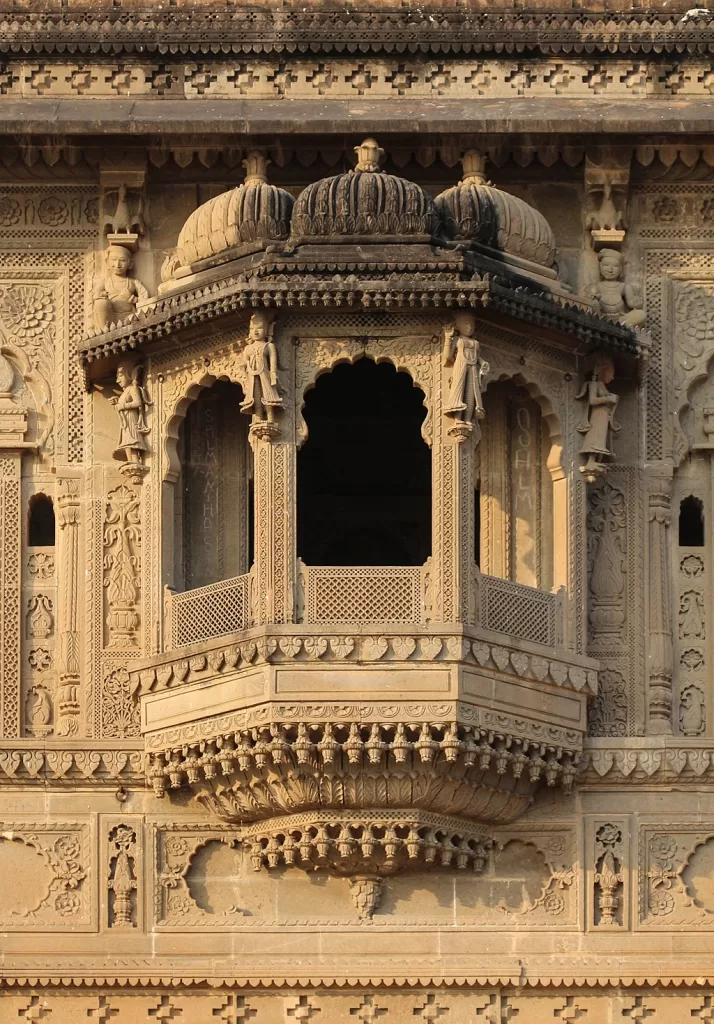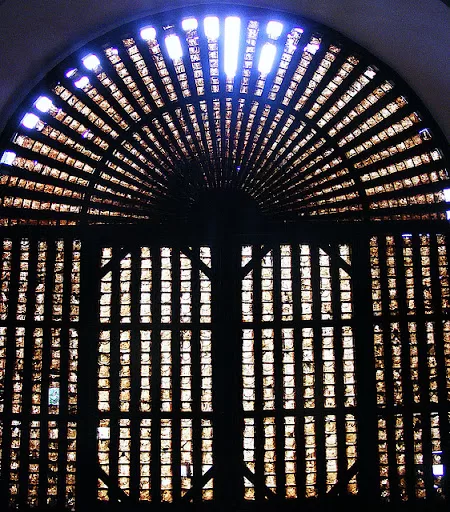Indian window designs are the rich tapestry of India’s architectural heritage. Windows take centre stage as eloquent storytellers, with each pane reflecting a distinct chapter of cultural fusion and craftsmanship. The diverse beauty of Indian window designs can be seen from the vibrant stained glass windows of Chettinadu mansions to the ornate Franco-Tamil windows adorning the streets of Puducherry and the intricately carved Likhai art windows of Kumaon. Master craftsmen across different regions showcased their skills in these unique architectural elements. These Indian window designs not only served practical purposes of ventilation and light but also stood as artistic expressions, illustrating the diverse influences that shaped India’s architectural identity. Join us on a journey through the diverse Indian window designs, where each frame becomes a portal into the cultural mosaic that defines the nation.
1. Chettinadu Stained Glass Windows

The “Chettinadu stained glass windows,” prevalent in Indian homes, dynamically showcase various styles. These windows feature large openable panels divided into six parts with square stained glass and timber frames, or smaller panels fixed over common wooden panels, highlighting vibrant primary and secondary hues. Outward-facing iron grills enhance visual appeal, contributing to the intricate charm of Chettinad’s architectural legacy within Indian homes. Despite the decline of many mansions, the continued utilisation of materials like stained glass from Belgium perpetuates the cultural narrative, preserving the distinctive lifestyle of the Chettiyars and their rich heritage.
2. Franco Tamilian window

Strategically positioned near thinnai and doors, the Franco-Tamil windows showcase captivating designs with ornate plaster and teak wood frames. Character-defining elements like brick arch lintels and inward-splayed window jambs enhance the craftsmanship. Meticulous artistry is evident in fixed shutters, directly attached to the wall with brass or wrought iron bolts. Security features, such as white-painted bands and wrought iron bars, enrich the blend of French and Tamil influences. The interplay of light and shadow on these windows perpetuates a timeless architectural symphony, elevating Puducherry’s cultural essence. French influence gave rise to the architectural style that we see throughout Puducherry-Franco-Tamil architecture.
3. Jalli windows

The jali windows, a marvel of architectural mastery, are intricately perforated stone screens found in Indian homes. Craftsmen craft these ornamental pieces with calligraphy and geometry, surpassing mere functionality and creating a mesmerising play of light and shadow. Artisans originated this architectural marvel as a solution to combat extreme heat in arid climates and to regulate light. The central panel showcases a lattice of interlocking curves, a geometric pattern capable of endless expansion.
4. Jharokha

The Jharokha window is a projecting, standout stone window overseeing the upper story of a building. Classical Indian architecture is particularly prominent in Rajasthan. It includes two pillars or pilasters, a balustrade, and a cupola or pyramidal roof, supported by two or more brackets or corbelling. Although technically enclosed, it is often partially open for residents to observe passing processions. The Jharokha is more formal and ornamental, standing out as a distinctive characteristic in medieval Indian architecture until the 19th century.
5. The Windows of Sarafs in Belgavi

The windows of Sarafs differed from others in the city and were a recurring feature across most houses on this street. They were designed to support the inhabitants’ traditional occupation of moneylending, giving the street its name—the street of the Sarafs.
Each window on the front facade is divided into three parts. The proportions of the details matched the anthropometry of a person seated on a gaddi (mattress) inside the front hall,. This enabled them to communicate with a person standing on the other side. The bottom part remained panelled, while the openable section featured a small wooden railing. This design ensured that the valuables kept by the moneylenders on the gaddi were out of reach for those seeking money. Above this section, grills spaced at a sufficient distance facilitated the exchange of goods and money. The top portion of the window shutter included additional, smaller shutters for peeping out without having to open the entire window during non-working hours.
6. Khorkhoris

The Khorkhori, inspired by the resonant “khadkhad” sound when opened, incorporated a wooden rod on the inside that connected to all the louvres, allowing for adjustable movement. Wood played a pivotal role in transforming fixed shutters into movable ones. The Khorkhori also functions as drop curtains with fixed horizontal wooden shutters, effectively preventing rain from entering the spacious verandas. A distinctive shade of green characterises the Khorkhori, which is obtained as hard lumps called beddi rang and crushed using a hamam-dasta. Oil and an adhesive material for window painting mixes with the resulting powder.
7. Likhai Art Window of Kumaon

The Likhai art window seen in old Kumaoni village homes features intricately carved windows with auspicious symbols, showcasing the traditional wood carving style known as likhai. Master craftsmen from the Oar community, also called Shilpakars, crafted these elaborate door and window frames. These are small, arched wooden windows with intricate likhai carvings on their facades. These intentionally small windows and doors, often made from walnut, horse chestnut, and Himalayan yew wood, also cater to the cold climate, trapping heat indoors.
8. Oyster shells window

The Oyster shell windows in Indian homes feature wooden frames with iridescent oyster shells arranged in a lattice pattern. These windows provided privacy from external gaze. They also allowed filtered light to enter, and minimised heat. The windowpane oysters, sourced from riverside beaches in the Zuari estuary, range from colourless to silvery white. The shells were collected from flatter specimens, cleaned, polished, shaped into squares or rectangles, and then fitted into grooved wooden slats of the windows. The flat part of the shell was meticulously cut to fit into the traditional wooden window pane frames of Goan homes.
9. Chettinad Wood-Carved Window

The Chettinad wood-carved windows exemplify exquisite craftsmanship, incorporating intricate patterns and detailed carvings. Crafted from high-quality wood, such as teak or rosewood, these windows showcase traditional motifs like floral patterns, peacocks, gods, goddesses, and mythological scenes. The design includes a vertical bar pattern within a wooden frame, providing openings for ventilation and privacy. At the same time, the play of light and shadow through the carvings actively enhances the interior ambiance. Furthermore, window niches and arches adorns with stucco work or paintings, adding an extra layer of artistic flair to these cultural treasures.
10. Chintz Painted Window

The Chintz painted window is a rare antique Indian painted window. These beautifully painted windows originate from the area of Bikaner in Northern Rajasthan, India. The central focus of these shutters is the Mughal tree of life design, with flowing floral motifs and birds surrounding it. Vivid mineral pigments create the striking colors. Originally, the purpose of these shutters was to cover the wall niche, which stored valuables. These windows are made of wood and iron.
Conclusion:
As we conclude our exploration of Indian window designs, it becomes apparent that these architectural marvels are more than just apertures to the outside world. They are active portals connecting us to the past, embodying the cultural amalgamation that defines the nation. From the vibrant hues of Chettinadu stained glass to the delicate Likhai carvings in Kumaon and the functional elegance of the Khorkhori, each Indian window design actively narrates a tale of craftsmanship, tradition, and adaptation. Let us appreciate the diversity and artistry encapsulated in these Indian window designs, recognising them not merely as passive architectural elements but as active guardians of cultural legacies, framing India’s rich history and heritage for generations to come.
Content Writing And Research By: Ar. Priyadarrshini Karthik
The post Through Time and Glass: Exploring 10 Indian Window Designs appeared first on The Architects Diary.
Leave a Reply